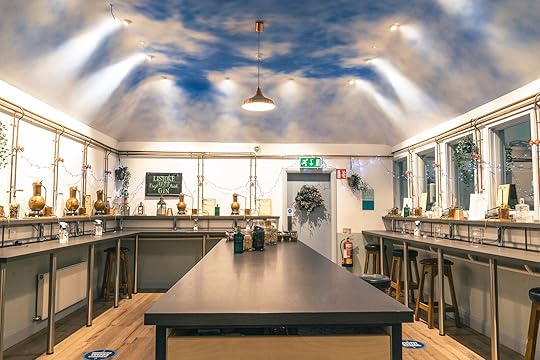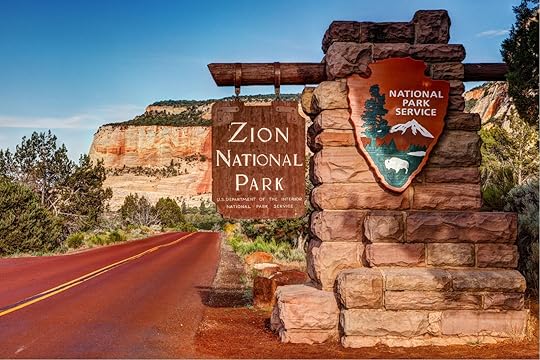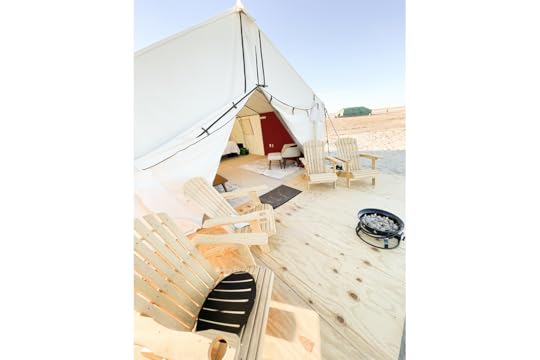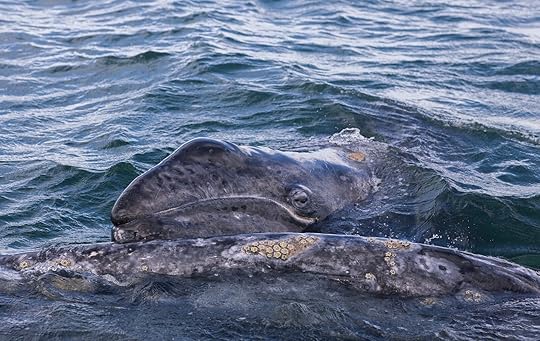Matador Network's Blog, page 513
March 15, 2022
This Gorgeous Colorado Distillery Makes the First Single Pot Still Whiskey Outside of Ireland

While American distillers indeed make singular spirits, there’s no denying that the history of American whiskey is inextricably linked to Ireland. The two countries are, after all, the ones that put the “e” in whiskey while most of the rest of the world follows Scotland’s “whisky.”
Yet it’s almost impossible to find American versions of one of the most classic styles of Irish whiskey: single pot still. Almost, but not entirely, thanks to Talnua Distillery in Arvada, Colorado, near Denver, which is the first American single pot still distillery making Irish-style pot still whiskey – a style that uses liquor from one distillery’s pot stills rather than the more common column stills.
Talnua opened to the public on St. Patrick’s Day weekend in 2019. It was close to a decade in the making. Co-founders Meagan and Patrick Miller first tasted Redbreast in 2011 on their honeymoon in a pub in Galway while watching the Ireland vs. USA Rugby World Cup game. A bartender working that day told the story and history of single pot still whiskey, and the two fell in love with the style. That first taste was an inspiration to start the first, and at this point only, US distillery dedicated to making single pot still whiskey.

Photo: Talnua Distillery
The St. Patrick’s Day opening was “a little bit intentional and a little bit of that luck of the Irish,” Talnua’s general manager Maya Oren tells me. The original opening date was in December of 2018, but that was pushed to February of 2019. The team decided to wait until St. Patrick’s Day for the grand opening, however, which allowed for some more time to plan the opening weekend festivities.
“The reception has been overwhelmingly positive and we are discovering the diversity of palates that enjoy single pot still whiskey,” Patrick Miller says. “Though there is often an educational hurdle in helping people understand this new style, it opens up amazing conversation and the excitement of being some of the first people to try this style of whiskey.”
It’s been equally well received in the home of single pot whiskey, too.
“Our reception in Ireland has been fantastic,” Miller says. “We are still a few years away from being able to distribute there, but we have already done a 2021 collaboration with Boann Distillery and there are more to look forward to on the horizon. It has been amazing to see the enthusiasm across the Atlantic in the ancestral homeland of single pot still whiskey.”

Photo: Talnua Distillery
Though the style isn’t common to the Americas, the people who first created it have long influenced the American whiskey of today. About 250,000 Scots-Irish immigrants from Northern Ireland, known as Ulstermen, came to the US in the 18th century. Many went to what was at the time the Wild West and is now the western parts of Pennsylvania, Maryland, Virginia, and North and South Carolina. These immigrants laid the foundation for what would become the American whiskey industry, according to the Distilled Spirits Council.
Talnua comes from the Irish-Gaelic word for land (talamh) and new (nua). Together, it’s a reference to Irish style whiskey being made in a new land. The logo connects the American distillery to Ireland as well: A bighorn sheep with its massive, curling horns (the state animal of Colorado) stands on the Flatirons of the Front Range and looks back at a triskele (a swirling triangle that’s one of the oldest Irish-Celtic symbols). Talnua’s motto is the Irish-Gaelic phrase “faugh a ballagh,” which means “clear the way.”
Colorado’s high-quality barley and water, as well as the wide temperature swings that encourage whiskey barrels to quickly impart flavor, make the state a great place for a single pot still whiskey, Oren says. The strong appreciation that Coloradans have for locally made beer and spirits — plus a culture of grabbing a drink after a day outdoors — helps, too.
The spirits that Talnua makes is unlike anything else that Colorado’s rapidly growing distilling community produces. And it’s all about style.
“Single” is used to describe any style of whiskey that’s made in one facility, versus a blend of whiskeys from various production centers. So a single pot still whiskey is one that’s made by a single distillery using pot stills. The Irish Technical File mandates that pot still whiskey must be made with at least 30 percent unmalted barley, 30 percent malted barley, and can include five percent other grains, like oats, corn, rye, or wheat. The flavor difference between unmalted and malted barley can be thought of as similar to the difference in flavor between cooked and uncooked apples.
Talnua isn’t in Ireland so doesn’t legally have to follow Irish whiskey category laws. They do, however, self-govern to follow them — including by taking the extra effort to use pot stills.

Photo: Talnua Distillery
On a trip with Powers Irish whiskey a few years ago to see the Irish Distillers Midleton Distillery (which is where Jameson and Redbreast are made, among others), I felt impossibly small standing next to the three 20,000-or-so gallon pot stills. The experience of standing next to the craft-distillery-sized pot stills at Talnua was of course much different. What came out of those stills, however, was just as enticing.
Pot still whiskey typically has a full body and notes of baking spice. Unmalted barley, which became common in Ireland to avoid the British malt tax of 1682, adds a strong cereal grain flavor that’s refined through three distillation runs.
You can taste a wide spectrum of what the style can do at Talnua. The distillery’s Heritage Selection Whiskey, made with a blend of Irish grain whiskey and Talnua’s own whiskey, is light and easy drinking. The Continuum Cask is a blend of whiskeys at least 18 months old that are continuously added as more whiskey is bottled so that the barrel never empties. The Bourbon Cask & Stave and Virginia White Oak Cask whiskeys may be more familiar to bourbon drinkers thanks to the aging process, while the Peated Cask has a hint of smoky peat from aging in barrels that used to hold Scotch whisky. All are triple distilled in traditional copper pot stills with a 50-50 malted to unmalted barley ratio (the same as the ratio that Dublin’s Teeling Distillery used for its first release).
At the distillery, a tasting room and cocktail bar has indoor and outdoor patio seating. A window wall provides a look to the distilling equipment and aging barrels in the back.
A visit wouldn’t be complete without a taste of Talnua’s other spirits. The Dutch-style gins, made with a base that uses the same 50-50 malted-unmalted barley as Talnua’s whiskey, are enjoyable sipped neat or mixed into one of the bar’s cocktails. At the distillery, you can grab a drink, sign up for a tour of the distillery, and buy some bottles to go. You can even bring your dogs.

Photo: Talnua Distillery
It’s a good time to be making Irish-style whiskey. Irish whiskey is one of the fastest growing whiskey categories in the US, and drinkers are becoming more open to trying traditional styles produced in parts of the world other than what has been historically available.
“The past five years have been an amazing time for single pot still whiskey because it marks a true revival for a historic style of whiskey making,” Miller says. “From a distillers standpoint, it is always exciting to pioneer a category and to be known as a producer of origin. We have a once in a lifetime opportunity to define a category and grow that into something truly special. From a drinking perspective, people are able to engage with whiskey history for the first time in nearly a century and rediscover a style that nearly went extinct.”
What are the Celtic nations

Celtic tribes once occupied much of mainland Europe, stretching as far east as modern-day Turkey. Over time, invaders forced the Celts west, and today, there are only six Celtic nations in the world clustered around western Europe, specifically parts of the United Kingdom, Ireland, and Brittany in France.
Celtic languages are the roots of the Celtic nationsSome argue that Galicia in northwestern Spain is the seventh Celtic nation as its Celtic heritage is evident to this day, but the six official nations are determined by the existence of a Celtic language that survived into the modern era and Galicia has none.
The six Celtic languages are:
Irish Gaelic (also known as Gaeilge)Scottish Gaelic (also known as Gaelic)WelshCornishManx (also known as Gaelic Manx)BretonThe six Celtic nationsWhile the similarities of the six Celtic nations are largely rooted in linguistics, each of these nations has artistic and social traditions, religious affiliations, and historic ties that at once unite and differentiate them. These are the six remaining Celtic nations, all distinct yet proud of their shared history and heritage.
1. Ireland
Photo: Arcady/Shutterstock
Ireland and Scotland are the most widely recognized Celtic nations, owing to their global reputations for Celtic pride and well-preserved cultural traditions. Celts arrived in Ireland around 500 BC, bringing with them new artistic, religious, technological, and social practices, as well as iron used to make tools and weapons. Among the most iconic relics are stone and metal Celtic crosses discovered in Ireland and Britain, which are said to have been introduced by St. Patrick in his mission to Christianize the pagans in Ireland. These and other ancient artifacts can be found at the National Museum of Ireland in Dublin and the Celtic and Prehistoric Museum in Dingle in County Kerry.
The arrival of the Celts also resulted in a new language, Irish Gaelic, which is still spoken and taught in Ireland today and considered the primary language of the west coast Gaeltacht districts. Together with Scottish Gaelic and the Manx language from the Isle of Man, Ireland’s traditional tongue is a Goidelic language, one of the two modern Celtic language groups. Myths like the Arthurian legend of Tristan and Iseult are essential to the written and oral histories of Ireland and the other Celtic nations. Traditional dance and musical customs are also celebrated in Ireland today. Even Halloween is believed to be rooted in the Celtic festival of Samhain, observed in Ireland for centuries between the fall equinox and winter solstice, marking the end of the harvest season.
For the best of Celtic culture in Ireland, visit during spring after Easter to take in the Pan Celtic Festival and see Celtic singers, dancers, and musicians from all six nations compete, as well as parades, street performances, storytelling sessions, fairs, workshops, and more.
2. Scotland
Photo: Kanuman/Shutterstock
Like Irish Gaelic, Scottish Gaelic is still spoken daily in several places throughout Scotland, particularly throughout the Highlands. The most famous Celtic tribes from ancient Scotland were the Gaels and the Picts who are believed to have intermixed around the late Iron Age around the 10th century. Steles known as Pictish stones bearing ogham inscriptions using the early Celtic alphabet (which looks straight out of Lord of the Rings) have been found around Scotland, representing some of the nation’s most important ancient artifacts alongside examples of Celtic crosses, knotwork, and designs used to decorate metal implements, jewelry, and clothing. History buffs would do well to check out the National Museum in Scotland to see art, carvings, and other artifacts from the Scottish Celts.
Other examples of Celtic heritage in Scotland are inextricably linked to the present-day country. Bagpipe music has Celtic roots and is one of the most iconic Scottish associations to this day. Several town names also trace back to ancient Scotland and Scottish Gaelic, including Pictish place names like Pitlochry, Pitsligo, Pittodrie, and Pitfichie. Even the Scottish affiliate of the BBC, called BBC Alba, celebrates the nation’s Celtic heritage by using its Gaelic name, Alba.
3. Wales
Photo: Helen Hotson/Shutterstock
Celtic heritage is integral to the national identity in Wales, called Cymru in the native tongue. Welsh is a Celtic language still widely spoken throughout the nation, much like Gaelic is still spoken in Ireland and Scotland but even more ubiquitously. It’s particularly prevalent in the west and north whereas English is the primary language in southern Wales. Unlike the Goidelic dialects, however, Welsh is a Brythonic language, meaning its roots are British rather than Irish. There were some Irish-speaking tribes in Wales at one time, though the evidence of their existence is limited to only a handful of inscribed relics.
Perhaps the most widespread remnants of ancient Welsh life are the traditional hillforts that dot the land between the Clwyd and Moel-y-Gaer rivers. While it’s still unclear as to whether they were used exclusively as defensive fortresses, housing, or both, the structures represent some of the best-preserved Celtic ruins anywhere in the Celtic nations. As artistic traditions go, Wales is known for its Iron Age La Tène art, largely comprised of metalworks ornamented with religious motifs, and the nation has a long and continuous Celtic literary tradition dating back to sixth-century poetry. To this day, Wales endeavors to celebrate its Celtic roots. One of the most impressive amateur art and poetry festivals anywhere in Europe, the National Eisteddfod of Wales, takes place every August in honor of the Welsh heritage and language.
4. Cornwall
Photo: Viktoria Rodriguez/Shutterstock
Cornwall is a county on the southwestern coast of England, appropriately positioned on the Celtic Sea. It’s inhabited by the Cornish people and traditionally went by the name Kernow. Similar to the languages of Wales and Brittany, Cornish is a Celtic language from the Brythonic tradition. Unlike Welsh, however, the Cornish language is not commonly spoken and was once declared extinct by UNESCO, having largely died out by the 18th century.
The good news is that it’s making a comeback thanks to Celtic revival movements focused on preserving Cornwall’s linguistic heritage. Now considered a critically endangered language but not extinct, Cornish is reappearing everywhere from local literature and film to school classrooms and everyday households. Even those not actively involved with the revival campaigns get a good dose of exposure to the traditional language as several place names in Cornwall are rooted in the traditional dialect, including Zennor and Penzance.
Despite being part of England, Cornwall developed a cultural identity distinct from both Britain and the neighboring Celtic nations due to its rocky, coastal, isolated location. This is reflected in its mythology, much of which revolves around the legends of King Arthur as the nation’s Dozmary Pool is fabled to be the home of the Lady of the Lake. The liveliest example of Celtic pride in Cornwall today is the annual Lowender Peran festival, which welcomes both local performers and those from the other Celtic nations and is generally held between October and November.
5. Isle of Man
Photo: ParrySuwanitch/Shutterstock
The Isle of Man is a small, self-governing island located between England and Ireland. Celtic influences trace back to the fifth century, during which time the Goidelic Manx language, a relative of Irish and Scottish Gaelic, developed despite earlier Brythonic influences. Much like Cornish, Manx did not survive long into the modern era though revitalization efforts have been slowly succeeding in preserving and reviving the Manx dialect, art, folk music, and general history. Since the 1970s, the island has hosted a popular Manx language music and cultural festival called Yn Chruinnaght as a tribute to its Celtic heritage.
While the Isle of Man is a dependency of the British Crown today, the island historically passed between Norwegian, Scottish, and British rule, but it has largely always fancied itself independent and even has the oldest continuous parliament in the world, called Tynwald. The island was uniquely never conquered by the Romans and therefore did not Christianize until the arrival of Irish missionaries spreading the world of St. Patrick in the fifth and sixth centuries, which also explains its longstanding linguistic ties to Gaelic.
Many of the stone crosses and artifacts discovered on the island bear ogham inscriptions while others show evidence of Scandinavian scripts. Other iconic reminders of the Isle of Man’s pagan past include rich folk tales, complete with fairies and sea gods; fishing, hunting, gathering, and maritime artifacts found at the Manx Museum; and the island’s official symbol, a triskelion comprised of three armored legs done up in spurs and radiating from a single point, a version of a popular pattern seen throughout the Celtic nations.
6. Brittany
Photo: canadastock/Shutterstock
Brittany, or Bretagne in French, juts out into the Atlantic from the west coast of France with the English Channel up north, the Celtic Sea in the northwest, and the Atlantic in the west. It’s the only official Celtic nation left on mainland Europe, both distinguishing it from the rest of France and the other Celtic nations. Celts are the first-known inhabitants of the area, which the Romans conquered in 56 BC when it was known as Armorica, loosely meaning “by the sea,” but did little to impact the culture. Fans of French comics might recognize the history from The Adventures of Asterix, which chronicles the resistance of a small village of Celtic Gauls from invading Roman forces.
Brittany’s namesake and much of its cultural heritage come from the British settlers who arrived between the fifth and sixth centuries after Anglo-Saxons invaded the British Isles. Today, French is the mother tongue of most natives, but the traditional Breton language, a cousin of Cornish and more distant relative of Welsh, is still somewhat widely spoken. In recent years, there’s also been a resurgence of Breton art and culture, including the establishment of Breton language schools and celebrations filled with veuze music, which is played on Breton bagpipes not unlike those associated with Scotland, sometimes by kilt-wearing bagpipers.
For an immersion into Brittany’s Celtic heritage, check out the Festival Interceltique, with its parades and concerts, taking place in August yearly in the Breton city of Lorient. 
A version of this article was previously published on March 15, 2019, and was updated on March 15, 2022.
More like thisArt + Architecture7 Picture-Perfect Irish Villages We Want to Escape toPhotos: Dust from the Sahara Turn Western Europe’s Sky Bright Orange

When residents of Spain, Portugal, and other parts of Western Europe woke up this morning, they weren’t greeted with a cheery sunrise, clear blue skies, or even cloudy grays. Instead, the sky was red-orange and layers of red-orange dust covered their terraces, streets, and cars.
Invasión de calima: España, ahora el país más contaminado de la Tierra
El polvo del Sáhara llega hasta Europa y el Atlántico tropical de la mano de la borrasca Celia.https://t.co/cdrMVEPvdv
Vía @MeteoredES pic.twitter.com/UJmpSNwiWr
— aggregatte (@aggregatte) March 15, 2022
Hot air from the Sahara Desert has traveled across the Mediterranean and turned the sky this red-orange hue, resulting in the National Air Quality Index to give Madrid and large parts of the southeast coast its worst rating — “extremely unfavorable,” according to The Associated Press.
Visibility in Madrid and cities like Granada and Leon was reduced to only a couple kilometers, the weather service said.
Schwer beeindruckend! (Aufnahme aus Klösterle, Vorarlberg) #Saharastaub
Quelle: Feratel pic.twitter.com/s93VbRX8hI
— wetterblog.at (@wetterblogAT) March 15, 2022
The country’s weather service forecast expects that the dust will continue through Wednesday. As the wind direction changes it is reaching countries like France, the Netherlands, parts of England, and northwestern Germany.
#SaharanDust now extends over an area of around 1.8 million square km …in the skies over western Europe https://t.co/a0Xx8VbpbP pic.twitter.com/6gCuCzXXHX
— BBC Weather (@bbcweather) March 15, 2022
This mass of hot air from Africa was brought in by Storm Celia that delivered a relief of rain as Spain has been hit with a drought. Many people believe the storm is a result of changing weather patterns due to climate change.
The wind is in from Africa … (Joni Mitchell) and it brings yellow dust from the Sahara to the Lake of Constance between Switzerland and Germany.#photography @ThePhotoHour pic.twitter.com/IrIvsl9eor
— VEOVEO (@richter_gert) March 15, 2022
It’s unclear at this point whether this is the worst dust storm for Europe on record but, as the Sahara Desert expands, so does the probability of dust storms. While small dust storms that travel around the world from the Sahara are common, it’s the large ones that are concerning. In 2020, a massive dust storm from the Sahara crossed the Atlantic and clouded skies in the Caribbean and Eastern US.
View this post on InstagramA post shared by Descubre Salinas (@descubresalinas)
In the meantime, officials say if you need to leave the house to wear the same facemasks that have been used during the pandemic. 
Our Editors Tested the Best Eco-Friendly Spring Hiking Gear — Here’s What’s Worth Your Money

The weather is beginning to warm across much of the United States, which means just one thing for hikers: it’s time to hit the trail. Given the variable conditions of mud season, dressing properly is key when snowmelt tends to soak stretches of trail and howling winds can unexpectedly ruin an otherwise-pleasant excursion. And considering the sheer number of brands making eco-friendly spring hiking clothes, there’s no reason not to dress in an environmentally friendly way.
Matador editors tested brands in each category below and compiled this list of the top low-impact spring hiking clothes. Here’s what we’re wearing from head to toe for spring hikes, with as small of a carbon footprint as possible. As a bonus, these items are available individually and make great gifts for the hikers in your life. Let’s hit the dressing room.
We hope you love the spring hiking clothes we recommend! Just so you know, Matador may collect a small commission from the links on this page if you make a purchase. Listed prices are accurate as of the time of publication. See our full Advertiser Disclosure here.
Top underlayers for spring hiking – Artilect base layers
Photo: REI
Spring weather is unpredictable, and the higher in elevation you go, the higher the likelihood that your starting weather won’t be the same as the weather a few miles in (or up). As such, a warm and flexible underlayer is the hidden — pun intended — key to a successful spring day outdoors. The best underlayer products for spring hiking come from upstart brand Artilect, out of Boulder, Colorado.
Start on top with the Artilect Boulder 125 Crew Base Layer Top ($100), available in both women’s and men’s varieties. This underlayer is super flexible and made of sustainable wool to absorb sweat as smoothly as it flexes with your movements. You’ll find that the Boulder Crew is perfect on cold mornings or in nearly all types of inclement weather. And because it’s vented, air moves through the fabric to keep you dry and cool even when it does warm up.

Photo: REI
Leggings or bottom base layers are especially important for early morning starts. Fortunately, Artilect’s Boulder 125 base layer bottom ($100) offers the same performance and comfort as its top. I’ve worn the men’s version of both the legging and top for the past two spring seasons and have come to rely on its durability and ability to neutralize shifting temperatures. Whether I’m touring in the backcountry on a splitboard mission or hiking a muddy early trail, not once have I found myself too hot or cold when wearing this base layer. Quite the opposite, actually — I typically forget I even have the layer on, which speaks to its comfort.
Read about Artilect’s sustainability efforts.
Top midlayer for spring hiking: Smartwool Intraknit
Photo: Airbnb
A spring midlayer should be loose but warm. It should be thick enough to mean you don’t need a heavy winter jacket, but tough enough to keep you warm in the face of strong wind or yoyoing temperatures. That’s what you’ll get with the Smartwool Intraknit Merino 200 base layer. Available as a quarter zip for women ($130) and a half zip for men ($150), the Intraknit offers back-of-the-beck protection and is made with a breathable fabric that excels in both warm and cool temperatures.
Smartwool is a leader in ethically sourced Merino wool and partners with ZQ Merino to ensure that animal, farmer, and land benefit from Smartwool’s sourcing and production. Plus, the Intraknit is superb for cool summer nights around a campfire, meaning you’ll definitely get your money’s worth for day and nighttime use.
Read about Smartwool’s sustainability efforts.
Top shell and outer layer for spring hiking: Garphyttan shirt jacket or fleece
Photo: Garphyttan
The unpredictability of spring weather goes both directions; sometimes it’s much warmer than expected. This makes layering for spring hikes all the more important. Because spring hiking is the time to leave the heavy down jacket or parka at the trailhead in favor of a lighter shell jacket on top of your base layers — otherwise, you may find yourself carrying a bulky down jacket after a few miles because it won’t fit in your daypack.
Swedish brand Garphyttan makes an incredibly versatile outer layer that’s easy to shed if the weather calls for it. It’s called the Specialist Shirt Jacket (for men, $139), or the Specialist Fleece (for women, $119). Garphyttan took honors in this category for two reasons. First, its outer layers are incredibly functional and flexible. And second, the brand includes functional pockets for your phone, wallet, and keys, none of which detract from the style. That’s especially important for women, whose products to have pockets too tiny to fit even a credit card while men get pockets big enough for an iPad. And it doesn’t hurt that you’ll look as good at happy hour as you do on the trail. The thicker fleece version (branded as women’s) doubles as a midlayer for winter use, too.

Photo: Garphyttan
Garphyttan also makes an incredibly durable outdoor pant for both women and men: the Specialist Trouser Light ($139). Spring hiking clothes need to be tough and waterproof as well as breathable, and this pant is all of the above. I’ve found in my testing that it’s super durable, and I’m confident it’ll last through years of heavy, rugged use.
This is a pant you buy once and won’t need to replace for years to come. All of Garphyttan’s clothes are Fair Trade certified and it uses polyester sourced in as eco-friendly a way as possible. Each item is OEKO-TEX certified, meaning it’s made with non-hazardous end products without harmful levels of toxic chemicals. The pants can be recycled into other clothing, if you ever decide to stop wearing them.
Read about Garphyttan’s sustainability efforts.
Top boots for spring hiking – Astral
Photo: Airbnb
Don’t forget the importance of having a good pair of boots in your spring hiking clothes setup. Waterproof boots are essential when every sun patch you pass through is damp with snowmelt runoff. You also need hiking boots durable enough to weather (again, intended) changing trail conditions and terrain ranging from dirt to rock to crusty snow. Small but growing brand Astral is the long-standing leader in sustainably made hiking footwear.
For spring, I’m opting for the Pisgah Waterproof Boot, available in women’s and men’s styles ($150). The boots are vegan and made with recycled polyester, but what makes the boot’s performance stand out from the rest are the super-soft EVA midsoles, which cushion the blow on your feet caused by changing trail conditions and uneven impacts. You want each step to feel the same, and Astral has that down with the Pisgah (with the added bonus of keeping your feet completely dry).
Read about Astral’s sustainability efforts.
More like thisBackpackingThe Ultimate Summer Backpacking Gear Guide for NewbiesWhat It’s Like to Craft Your Own Custom Gin at Ireland’s Only Gin Distilling School

I first discovered Listoke Distillery & Gin School while planning a road trip to see some of Ireland’s most stunning castles. Despite being tucked away among the country’s most narrow and winding roads, Listoke seemed more than worth the added detour – after all Listoke Distillery is the only gin distillery in all of Ireland.
Listoke Distillery came bursting onto the scene in 2016 with its slick branding, spicy orange flavors, and contemporary Gin School, another first in Ireland. Listoke is the brainchild of nurse turned distiller, Bronagh Conlon. Located on the outskirts of Drogheda, the distillery is just a mere 45 minutes north of Dublin, yet it still feels like a curious and hidden gem. Together with her family, Conlon has masterfully created a small-business brand with a larger-than-life outreach. This concept – a distillery which combines a distillery with classes on how to craft gin cocktails, intrigued me immediately, and I decided I needed to stop by for a tour.

Photo: Courtesy Tiffany Eastham
When I arrived, I was greeted by Sarah McAvinchey, Conlon’s daughter and director of sales, who agreed to give me a behind the scenes tour of what makes their gin school so special. A self-taught master distiller herself, McAvinchey explained that their flagship gin, Ireland Listoke 1777, has won multiple awards including Best Irish Gin and Best Gin in Europe. She describes their signature product as having warm and spicy notes that are enhanced by cardamom pods and cassia, while their citrus of choice is orange peel with a hint of jasmine. Most gins tend to favor lemon, but the warming orange notes of Listoke 1777 create a beautifully balanced taste.
Listoke Distillery & Gin School offers a three-hour immersive experience in all things drinking and distilling gin. After some ground rules, guests are served a welcome gin and tonic featuring their Listoke 1777, but the gin continues to flow throughout the duration of the class. The distillery’s “no empty glasses” policy ensures you get the full gin tasting experience.

Photo: Courtesy Tiffany Eastham
At the beginning of the class, I’m led into the official Gin School room that was lined with sparkling copper stills and glass jars filled with dried botanicals. Four larger jars sat in the middle of the island that McAvinchey described as the “core four.” Ninety-nine percent of gins will include juniper, coriander, angelica root, and orris root. This is the starting base.

Photo: Courtesy Tiffany Eastham
After blending the recommended amounts of core ingredients, guests are left to mix and match among the variety of additional citrus, floral, and spicy ingredients. Each botanical comes with an identification tag and suggested quantity, but it’s up to the student distiller whether or not to actually follow the recommended amounts – it’s your custom blend after all. The instructors offer guidance and suggestions to those that want it, but they encourage a fun, relaxing, and educational atmosphere that doesn’t adhere to a strict timeline.
McAvinchey remarks that if you favor a punchier gin, for example, try kicking up the pink peppercorns or another spice in your concoction. I prefer fruity and floral notes, so I’d be more inclined to add rosebuds and dandelions to mine. The combinations are nearly endless, and that’s what makes distilling your custom gin a personal journey.

Photo: Courtesy Tiffany Eastham
Once the mixing and matching is complete, each member of the class is presented with their own one-liter copper still and a connected network of coils that circulate around the room. From here, the distillery process is pretty simple. Listoke uses a base alcohol that, together with the mixture of botanicals, will boil and steam to perfection as part of the distilling process. This “set it and forget it” method takes a mere 30 minutes from start to finish.
While we wait for our gin to finish distilling, I’m led out to the warehouse for a proper tour of their stills that are responsible for creating the distillery’s signature flavors. I’m immediately hit with that same punchy, sweet aroma of a freshly distilled Listoke 1777 before being guided to the bottling station. McAvinchey proudly admits that her’s is the only distillery of this scale that still bottles and labels each product by hand.
The final minutes of distilling are spent enjoying a spread of local meats and cheeses with another round of gin and tonics. Those last drops of freshly distilled gin eventually make their way into your very own bottle that is sealed and labeled with Listoke’s signature owl logo.
I left Listoke Distillery with a fantastic local experience, a new appreciation for the distilling culture, and a generous amount of gin in my purse. It’s distilling classes typically run every Friday evening, Saturday afternoon, and Saturday evening. You can also find their gin in some spots around the United States, most countries in Europe, and even China.
Head to their website to check out the distillery or sign up for a class, and if you ever find yourself with a stopover in Dublin, venture out of the city for an experience that won’t disappoint. 
The ultimate guide to Irish accents

The people of Ireland get annoyed with the fake Hollywood Irish accent and there’s a good reason for that: There are many different Irish accents, not just one.
Irish accents vary by counties, of course. People from Derry speak very differently from those in Roscommon, and people from Limerick don’t sound the same as the ones from Mayo. But even within these areas, there is an assortment of accents. In Ireland, you truly only need to drive 10 miles in any directions, and you’ll hear a different pronunciation of the English language.
In county Offaly, for example, people in Tullamore sound different from the ones who live in Birr. And you only need to cross the Liffey via O’Connell Bridge to realize that South Dubliners and North Dubliners have a very different pronunciation, indeed.
While this humorous guide misses a few important spots, like Donegal and the Midlands, the Irish accents explained are very accurate. Nobody truly understands the poor people of Kerry, and the inhabitants of Cork get their fair share of slagging from the rest of the country for their unique melodic pronunciation.
Besides showing off the multitude of Irish accents, the makers of the video indulged in some funny, but outdated clichés. Kerry is a rural county, hence of the illustration of a farmer and his cow. Limerick has the reputation to be rough around the edges, which explains the knife-wielding masked man. North Dubliners are also often represented as lower-class people while South Dubliner have the reputation to be posh and a little pretentious.
Have a watch and try to remember that even when you have mastered the accents, you’ll only truly blend in your chosen area when you’ll start peppering you conversations with Irish expressions such as “The head on you and the price of turnips.” 
A version of this article was previously published on March 14, 2015, and was updated on March 15, 2022.
More like thisLanguages8 Irish Gaelic Sayings about Guinness, Tea, and God That’ll Help You Understand Irish CultureMarch 14, 2022
United Just Made it Incredibly Fast to Check a Bag at These 7 Airports

When flying, there’s a big question you have to ask yourself: to check a bag, or not to check a bag? Team checked-bag tends to enjoy the freedom it awards you. After all, when you check a bag, there’s no measuring liquids, no need to squeeze everything into a small carry-on, and no need to take much out once you arrive at security. Team carry-on has the upper hand when it comes to avoiding the baggage fee, however, and there’s no waiting in the ticketing line upon arrival or after your flight at baggage claim.
The dynamics are changing a bit for some who fly on United Airlines out of certain hub cities, though. The airline has handed team checked-bag another win with its new bag drop shortcut, which will allow customers who check in prior to arrival to skip the line and check a bag in a minute or less on average, virtually eliminating this part of the journey.
“Our initial customer data proves this free, simple-to-use process saves our customers time and energy as they get ready for their flight,” Toby Enqvist, chief customer officer for United, said in a press release. “We’re thrilled to be the first to offer this service to all customers who check-in on our award-winning mobile app.”
To be eligible, customers must check in on the United app and select the number of bags. Once in the airport, customers can find the bag drop, place their bag on the scale, and scan their boarding pass at the kiosk. After a United staff member checks the customer’s ID, they’ll apply the bag tag and customers can head to security.
Airports with United bag drop shortcut serviceChicagoDenverHoustonLos AngelesNew York/NewarkSan FranciscoWashington DCCustomers can expect the program to expand to dozens more airports this year. 
Brushing your teeth in airplanes

This is the Travel Take, where Matador’s writers and editors make the case for their favorite travel hacks, tips, and personal tics.
Airplane bathrooms are disgusting. There’s no way around the fact that when 300-plus passengers share six lavatories on a long flight, the facilities get nasty, and get nasty fast. Flight attendants do their best to keep them decent, but it’s hard to make the teeny tiny smelly box that passes for a bathroom remotely satisfactory — especially in economy.
That said, a gross bathroom is no excuse for not brushing your teeth during a flight. A good rule of thumb for airplane buccal hygiene is: If you ate a meal on board, then brush your teeth. After all, we’ve been told by dentists for decades that we need to brush our teeth at least twice a day, and that brushing three times a day can lead to better heart health, so why would that change when we’re in an airplane?
But despite being backed by just about every tooth expert in the world, my seemingly irrefutable logic is not one that everyone is on board with. When I briefly mentioned brushing your teeth during a flight to a room full of travelers who spend a shocking amount of time in airplanes, I was met with a chorus of “ick” and “yuck”.
Apparently, my dental regimen, although impeccable, made me the scummy one.
Brushing your teeth on a flight does not mean you have to put your toothbrush down by the sink or close your mouth around the tap. You can go through the entire operation without making it nauseating. Just keep your toothbrush away from the high-touch surfaces and gather water from the tap in your cupped hands — that’s not rocket science.
But as I understand from my extremely sanitary coworkers, the water from an airplane tap is one of the foulest things out there. I am officially the office dirtbag.
The United States Environmental Protection Agency is in charge of setting standards for water quality in airplanes, as well as enforcing those standards. The water that comes from the bathroom tap should be safe, technically. And despite studies that have shown that the water quality varies (sometimes drastically) by airline, I choose to believe I can swish half a cup of the stuff in my mouth and spit it out without getting sick. So far, despite my ostensibly filthy habit, I have not.
But if the cleanliness of the water is too big a worry for you to start brushing your teeth during a flight, you have options. Get a cup of water from the crew or grab one of the small bottles of water provided with your meal or seat, and use that to rinse your mouth and clean your toothbrush. There’s nothing vile about that.
Brushing your teeth during a flight is not gross — not brushing your teeth is. Airlines don’t pack amenity kits with toothbrushes and mini tubes of toothpaste for the glory of it all — they do it so that passengers use them and arrive fresh at their destination.
Of course, you can brush your teeth at the airport before boarding and after landing, but why would you want to wait? It’s not just about consideration for the people you are traveling with or the people around you (those may be protected from your bad breath or the food items stuck in your teeth by the current mask mandate onboard airplanes), but for your own personal hygiene and comfort.
If my tirade has convinced you to take a leap towards better mouth health while flying, go even one step further and bring some floss. 
Don’t Hit the Road Without Reading this Perfect Las Vegas to Zion Itinerary

Asphalt roads are usually just a means to an end for an ordinary traveler – but if you’re going from the glitz and glam of Las Vegas to the dramatic sandstone walls of Zion National Park, the journey demands some extra time. The 160-mile drive can be done in just a little over two and a half hours. But any good road trip is all about the journey, and there’s plenty to explore between Las Vegas to Zion, especially deeper into the desert. From local food stops to miles of scenic hiking and even a deserted ghost town, make your road trip from Las Vegas to Zion National Park memorable with the ultimate two-day itinerary below.
Las Vegas to Zion National Park: what to know
Photo: TFoxFoto/Shutterstock
Here are four useful tips to keep in mind on the drive:
Remember: there’s a time change. Be sure to set your clocks ahead an hour after crossing the border from Nevada to Utah.Know Utah’s DUI law. Even just one drink might put you over the limit. Utah has the strictest DUI laws of any state with a blood alcohol content limit of 0.05 percent compared to the rest of the country at .08 percent. Of course, you should never drink and drive, but you need to be especially aware of it in Utah.Make reservations ahead of time if you plan to stay in Springdale and especially if you want to camp in the park. Road trips can be full of spontaneous decisions but finding lodging near Zion National Park should not be one of them, especially if you visit during the peak summer season.Buy an America the Beautiful Pass. Most people combine a visit to Zion National Park with other national park sites in Utah. Good for an entire year, this $80 pass covers entry fees to all national parks and many other public lands, including the first stop on this itinerary (but note it does not cover state parks).Day One: Las Vegas to St. GeorgeDriving distance: 183 milesTotal drive time: 3 hours, 30 minsLeave the traffic and noise behind as you head out of Las Vegas and continue north into the heart of red rock country.
Stop one: Red Rock Canyon National Conservation AreaStart the trip off with a short detour east of Las Vegas to the Red Rock Canyon National Conservation Area and see what the red rock hype is all about. Move along the park’s 13-mile Scenic Drive at a leisurely pace and don’t forget to make use of the pull-offs. There are 26 officially listed hikes and trails if you want to stretch your legs along the way. The Calico Tanks trail, in particular, offers a good introduction to the area; it’s a moderate 2.5-mile trail that winds its way through a wash to a natural tank. After a slight climb at the end, hikers are rewarded with a distant view of downtown Las Vegas.
Looking for something easier? Take the Moenkopi two-mile trail from the visitor center for excellent panoramic views. Summit-baggers can opt for the more strenuous five-mile hike to Turtlehead Peak, a prominent sandstone formation. Don’t be fooled by the short distance — its difficult.
Note: Timed reservations are required for vehicle entry to the Scenic Drive between 8 AM and 5 PM from October 1 to May 31. Entrance is free if you have the America the Beautiful Pass.
Stop two: Valley of Fire State Park
Photo: Filip Fuxa/Shutterstock
It’s no secret how this park got its name: the rocks exude a warm glow when the sun reflects off their bright red Aztec sandstone, creating what appears to be a Valley of Fire. This state park contains stunning rock formations, numerous petroglyphs, and petrified trees. Be on the lookout for some of the park’s elusive wildlife, including desert bighorn sheep. While there are many hikes to choose from, the Fire Wave, White Domes Loop, and Atlatl Rock are the best hikes for getting a sense for the park’s beauty.
Fire Wave: This 1.5-mile trail leads to a unique swirling red, white, and pink sandstone formation that resembles an ocean wave.White Domes Loop: A 1.1-mile loop winds through some of the park’s most scenic and varied landscapes, including towering sandstone formations, dry washes, and a small slot canyon.Atlatl Rock: More of a walk than a hike, this picnic area is not far off the main Valley of Fire Road. A set of stairs leads visitors to the huge rock covered in petroglyphs thousands of years old.Stop three: Nielsen’s Frozen CustardEnd the day at Nielsen’s Frozen Custard in St. George, Utah. What started as an addition to Steve and Debbie Nielsen’s family farm in Bountiful, Utah quickly became a custard sensation. Today, there are five locations in Utah and one in Las Vegas. It’s still a true family business as three generations of Nielsens work at the various locations.
The diners have a vintage feel with neon signs and cozy red booths. Their food is good, sure, but you’re coming here mostly for dessert. Nielsen’s specializes in “concretes” – thick shakes made with custard and whatever add-ins you fancy. The options are as limitless as your imagination. Caramel-pineapple-cashew, if you want – why not?
Day One: Where to stayWe hope you love the Las Vegas to Zion stays we recommend! Just so you know, Matador may collect a small commission from the links on this page if you decide to book a stay. Listed prices are accurate as of the time of publication. See our full Advertiser Disclosure here.
St. George is filled with lodging options, ranging from campgrounds to motels and every chain hotel that comes to mind. There are plenty of places to stay. Consider the Best Western Plus Abbey Inn, with a year-round heated pool for those chilly, desert evenings. For something more hip, The Avenire offers midcentury-meets-western rooms with a fabulous restaurant and bar, and Inn on the Cliff is a contemporary boutique hotel with private balconies and a restaurant overlooking the St. George valley and red rocks in the distance.
If you’d prefer to camp, the best spot is Snow Canyon State Park. If you love red rocks, go here. It’s arguably as beautiful as the state’s national parks and will give you a taste of what to expect at the end of your Las Vegas to Zion road trip. If you camp here, wake up early to catch the sunrise in one of Utah’s most popular state parks.
Day Two: St. George to SpringdaleDriving distance: 52 milesTotal drive time: 1 hour, 35 minsOn day two driving from Las Vegas to Zion National Park, towns become increasingly smaller. It doesn’t take long for shops and fast-food restaurants to give way to expansive red rock vistas.
Stop one: St. George Dinosaur Discovery SiteStart the day by indulging your inner paleontologist. Utah is rich in prehistoric history and archeological areas. The fossils at the St. George Dinosaur Discovery Site were discovered fairly recently (in 2000), but that’s just a blink of an eye in geologic time. Today, the site houses fossils from across the area and houses the largest collection of swim tracks – long scratch marks on muddy lake bottoms made by dinosaurs swimming across – in the world. In addition to fossils and fascinating displays, they also have a fossil preparation lab where visitors can watch volunteers and paleontologists at work.
Stop two: Sand Hollow State Park
Photo: Adventures On Wheels/Shutterstock
Water in the desert? Absolutely. This man-made reservoir has water activities ranging from relaxing on the beach or leisurely kayaking and fishing to more adrenaline-pumping activities like wakeboarding and jet-skiing. It’s about 100 feet deep, so you can even scuba dive on the intentionally sunk planes, boats, and vehicles.
If you prefer land to water, the park has ATV and OHV rentals you can use to explore it’s 62,000 acres of trails and sand dunes.
Road tripping from Las Vegas to Zion National Park in February? Time it to coincide with SkyFest, when hot air balloons launch just outside nearby Sand Hollow Resort at sunrise.
Stop three: River Rock Roasting Co. and BakeryDon’t be fooled by the name: this place offers up more than just delicious coffee and homemade baked goods. The main location on State Street serves a full menu with sandwiches, burgers, salads, and pizza (try the “Beetza Pizza” for something different).
If you’re looking to whet your whistle after a day exploring, River Rock has a variety of wine and local Utah beers on tap. In addition to indoor seating, they have an outdoor dog-friendly deck with views overlooking a basalt canyon and the Virgin River.
In a rush? River Rock also operates a drive-through location serving drinks and baked goods. it’s just after Highway 9 on the way to Zion National Park.
Stop four: Grafton Ghost TownThe ghost town of Grafton is just a couple miles off the main road so it won’t be a very long detour. Originally settled in the mid-1800s, it had a school, a church, a post office, and a community center. The abandoned settlement is now a tourist attraction and filming location, most notably for 1969’s Butch Cassidy and the Sundance Kid. Today, visitors can see the preserved remnants of the schoolhouse, several houses, and the graveyard.
The paved road turns to clay shortly after turning on Bridge Road. While any vehicle can navigate the terrain, the clay can get quite slick, so you’ll probably want to avoid it during or right after heavy rain.
Day Two: Where to Stay
Photo: James Marvin Phelps/Shutterstock
Stay in Springdale, just outside the south entrance of Zion National Park. This gateway community is filled with art galleries, souvenirs shops, restaurants, outfitters, a dog park, rock and crystal shops, and more. It has all the conveniences of a larger town while still retaining its local vibes.
A good choice is the Driftwood Lodge. It’s less than two miles from the park entrance and many rooms have balconies with views of the surrounding canyons and cliffs. Cliffrose Springdale, Curio Collection by Hilton is a good pick if you want amenities like a pool, hot tub, on-site spa, or morning yoga classes.
If you want to camp but couldn’t snag a spot in the park, try Zion Canyon Campground and RV Resort. It’s Springdale’s only campground and is as close to the park as possible without being in it. Several sites are along the Virgin River and look out on Zion National Park’s Watchman Campground. Under Canvas Zion is an exceptionally cool glamping resort, and while it’s just as expensive as any hotel, the experience of sleeping in a safari tent and having access to nighttime stargazing and bonfires may make it worth it. There are also lots of home rentals and cabins near the park.
Springdale will generally be more expensive than turns further away, but the location makes it easy to beat the crowds into the park (and find parking near the visitors center).It also means you can likely walk to a free town shuttle stop to avoid the hassle of parking all together.
Day Three: Zion National Park
Photo: Lian Law
Zion National Park truly showcases the beauty of the desert. With its vibrant orange and burnt umber cliffs, dramatic night sky, and the lure of adventure, it’s hard not to be over-awed by a visit to this national park. 
More like thisNewsZion National Park is Now a Certified International Dark Sky Park
This Luxe Glamping Lodge in Mexico will Make Your Whale-Watching Dreams Come True

As a freelance adventure photographer, I’ve been fortunate enough to travel the world, always trying to capture its natural beauty. And as an avid surfer, I’ve always had a deep appreciation for the ocean and its myriad varied creatures, from tiny sea slugs to enormous sharks. So when I had the chance to spend a long weekend with Nautilus Adventures in San Ignacio, Mexico, to spend three days whale watching in Baja California, I jumped at the opportunity.
Starting from Cabo San Lucas, I took a short two-hour flight to the San Ignacio Lagoon, where the adventure got underway. Immediately after we landed, we were out on the water, scanning the horizon for any kind of whale activity from the migrating cetaceans, like spouts, breaching, or spy hops. Armed with our experienced captain and guide, it seemed like it took no time at all before the Nautilus crew was able to position us in a prime spot to see the region’s many whales. Seemingly without impacting the whales’ normal behavior, we were able to get close enough to touch a baby gray whale (which is legal in this part of the sea; more on that below.) And this wasn’t some cheesy Sea World experience — it was an open-water, wild animal interaction. And it was magical.
With good ocean conditions, as we had, travelers can expect to whale watch in Baja California for about four or five hours a day. Mornings involve layering up with a windbreaker to cut through the chilly air, but by the time the afternoon tours started, it was warm enough for t-shirts and shorts. After we came back on land in the late afternoon, we’d retreat back to the incredible Nautilus camp.
My glamping tent had a comfortable full-sized bed, hotel linens, a sitting area, an en-suite bathroom, and even Wi-Fi. And because the multi-course meals and snacks are included in the flat rate, everything feels comfortable and family-style, especially since the groups are usually relatively small. It was a surprising amount of luxury and comfort for being essentially in the middle of nowhere.
Though the five-day trip felt like it went by in a blink, the Nautilus team does a great job of ensuring everyone has enough time to take fantastic photos of the grey whales as well as other species like dolphins and — lucky us — orcas, which are rare. Whale watching in Baja California was the highlight of the last few years for this travel photographer — and the photos prove it. 

Before my trip, I stayed at the Barcelo Resort in Cabo San Lucas. It’s an all-inclusive and was comfortable, convenient, and had plenty to do for a few days. It’d be a great spot to stay before or after if you wanted to extend your trip for a few days. Photo: Barcelo Cabo San Lucas

While flying from Cabo to San Ignacio, you’ll be treated to views of electric blue water and dry desert landscape colliding along the coastline. Nautilus Dive Adventures charters a private plane for everyone on the tour (included as part of the cost), so you don’t have to deal with any of the organizational details yourself. The flight takes about two hours. Photo: Jason Mar

As a part of the luxury package, every accommodation comes with its own patio, Adirondack chairs, and fire pit. Inside, there are comfortable furnishings and roomy private bathrooms. Though it’s technically glamping, it feels like a luxurious hotel inside and is very peaceful at night. Photo: Jason Mar

You won’t be able to keep yourself from rushing to the side of the boat when these incredible animals come close. The whale-watching boats are tiny, but you only spend a few hours on them at a time, coming back to camp for lunch midday and happy hours. Photo: Jason Mar

While you’re on the boat, you’ll want to constantly scan the horizon in order to catch any kind of whale activity. While this may look like one whale at first glance, it’s actually two, possibly mating below the surface. Photo: Jason Mar

Orcas are extremely uncommon for the lagoon and have been known to eat dolphins and baby gray whales. We were very nervous to see if they would approach any gray whales; fortunately they left without incident. It was a rare treat to see them. Photo: Jason Mar

It’s hard not to feel a surge of emotion and excitement as the 50-foot-long animals approach the boat. Sometimes, they want to get a closer look at you as much as you want to look at them. Photo: Jason Mar

The behavior exhibited here is called a “spy hop.” Whales swim to the surface and get their eyes above the water to spot what’s going on in the distance. It’s a common behavior, especially with other whales or boats nearby. Photo: Jason Mar

This young and curious gray whale calf came close enough to our boat with its mother to check us out. Humpback whale mothers are very affectionate and protective, and calves tend to stay with their mother for around a year after a birth before heading out on their own. Photo: Jason Mar

During the trip, you’ll spend three nights at the Nautilus eco-camp. Guests are welcomed with sparkling wine and the accommodations are luxurious and comfortable. With clear skies and zero light pollution, make sure you look up at night to see the stars dancing across the sky. Photo: Jason Mar

Even without seeing whales, this would be an amazing trip. I had breakfast each morning on the deck outside my tent, thinking about the stories that will stay with me forever. Photo: Jason Mar

The whales are naturally curious animals and unafraid of the boats. They’re actually attracted to the sound of the motor and will even get close enough for guests to touch them. While it’s illegal to get within 300 feet of whales in the wild in the US, that’s not the case in the San Ignacio Lagoon – it’s one of the few places in Mexico where you’re allowed to pet them. However, the number of boats allowed on the water at any given time is limited, and all whale-watching companies have to pay into the salary for a “whale sheriff” to make sure tour operators are being responsible. That makes it one of the few places in the world where you can have an experience like this with a wild animal. You can read more about it here. Photo: Jason Mar

You’ll spend nearly all your time over the four days with your small tour group, and the shared enthusiasm for whales and wildlife makes it easy to make friends. It doesn’t take long to feel like old friends, especially since you’ve all made memories together to last a lifetime. Photo: Jason Mar

More like thisWildlifeThe Best Places to Go Whale Watching in California this Winter
Matador Network's Blog
- Matador Network's profile
- 6 followers



